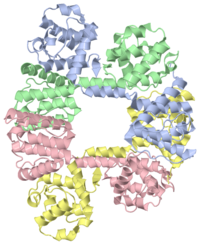From Proteopedia
(Difference between revisions)
proteopedia linkproteopedia link
|
|
| Line 1: |
Line 1: |
| - | [[Image:1dxx.gif|left|200px]] | + | {{Seed}} |
| | + | [[Image:1dxx.png|left|200px]] |
| | | | |
| | <!-- | | <!-- |
| Line 9: |
Line 10: |
| | {{STRUCTURE_1dxx| PDB=1dxx | SCENE= }} | | {{STRUCTURE_1dxx| PDB=1dxx | SCENE= }} |
| | | | |
| - | '''N-TERMINAL ACTIN-BINDING DOMAIN OF HUMAN DYSTROPHIN'''
| + | ===N-TERMINAL ACTIN-BINDING DOMAIN OF HUMAN DYSTROPHIN=== |
| | | | |
| | | | |
| - | ==Overview==
| + | <!-- |
| - | BACKGROUND: Dystrophin is an essential component of skeletal muscle cells. Its N-terminal domain binds to F-actin and its C terminus binds to the dystrophin-associated glycoprotein (DAG) complex in the membrane. Dystrophin is therefore thought to serve as a link from the actin-based cytoskeleton of the muscle cell through the plasma membrane to the extracellular matrix. Pathogenic mutations in dystrophin result in Duchenne or Becker muscular dystrophy. RESULTS: The crystal structure of the dystrophin actin-binding domain (ABD) has been determined at 2.6 A resolution. The structure is an antiparallel dimer of two ABDs each comprising two calponin homology domains (CH1 and CH2) that are linked by a central alpha helix. The CH domains are both alpha-helical globular folds. Comparisons with the structures of utrophin and fimbrin ABDs reveal that the conformations of the individual CH domains are very similar to those of dystrophin but that the arrangement of the two CH domains within the ABD is altered. The dystrophin dimer reveals a change of 72 degrees in the orientation of one pair of CH1 and CH2 domains (from different monomers) relative to the other pair when compared with the utrophin dimer. The dystrophin monomer is more elongated than the fimbrin ABD. CONCLUSIONS: The dystrophin ABD structure reveals a previously uncharacterised arrangement of the CH domains within the ABD. This observation has implications for the mechanism of actin binding by dystrophin and related proteins. Examining the position of three pathogenic missense mutations within the structure suggests that they exert their effects through misfolding of the ABD, rather than through disruption of the binding to F-actin.
| + | The line below this paragraph, {{ABSTRACT_PUBMED_10801490}}, adds the Publication Abstract to the page |
| | + | (as it appears on PubMed at http://www.pubmed.gov), where 10801490 is the PubMed ID number. |
| | + | --> |
| | + | {{ABSTRACT_PUBMED_10801490}} |
| | | | |
| | ==Disease== | | ==Disease== |
| Line 34: |
Line 38: |
| | [[Category: Muscular dystrophy]] | | [[Category: Muscular dystrophy]] |
| | [[Category: Utrophin]] | | [[Category: Utrophin]] |
| - | ''Page seeded by [http://oca.weizmann.ac.il/oca OCA ] on Fri May 2 14:24:52 2008'' | + | |
| | + | ''Page seeded by [http://oca.weizmann.ac.il/oca OCA ] on Mon Jun 30 23:47:12 2008'' |
Revision as of 20:47, 30 June 2008
Template:STRUCTURE 1dxx
N-TERMINAL ACTIN-BINDING DOMAIN OF HUMAN DYSTROPHIN
Template:ABSTRACT PUBMED 10801490
Disease
Known disease associated with this structure: Becker muscular dystrophy OMIM:[300377], Cardiomyopathy, dilated, 3B OMIM:[300377], Duchenne muscular dystrophy OMIM:[300377]
About this Structure
1DXX is a Single protein structure of sequence from Homo sapiens. Full crystallographic information is available from OCA.
Reference
The structure of the N-terminal actin-binding domain of human dystrophin and how mutations in this domain may cause Duchenne or Becker muscular dystrophy., Norwood FL, Sutherland-Smith AJ, Keep NH, Kendrick-Jones J, Structure. 2000 May 15;8(5):481-91. PMID:10801490
Page seeded by OCA on Mon Jun 30 23:47:12 2008

